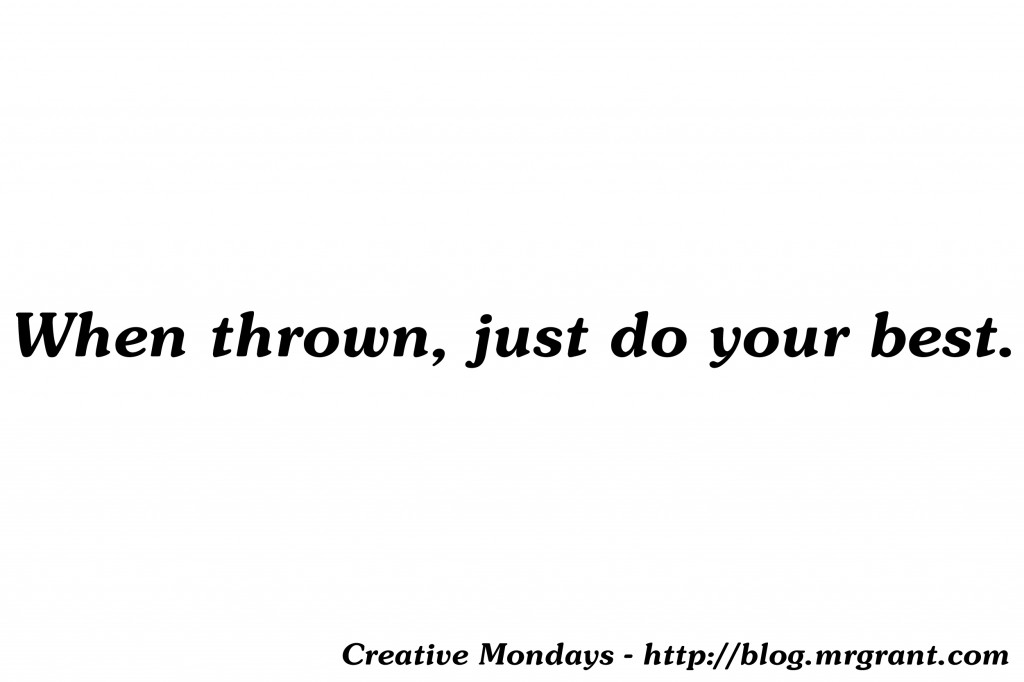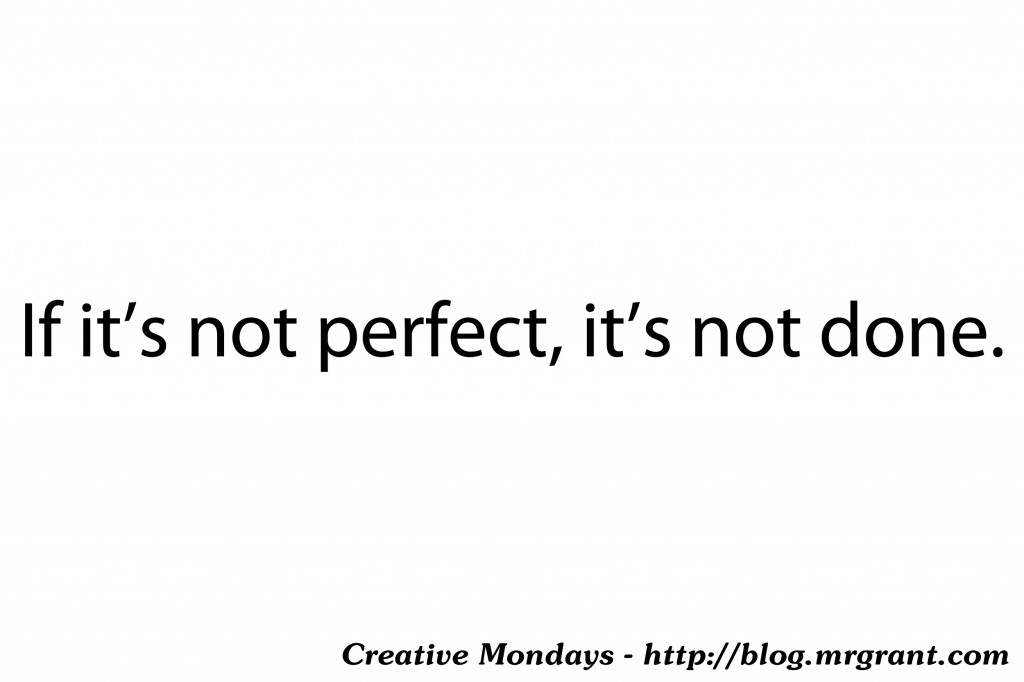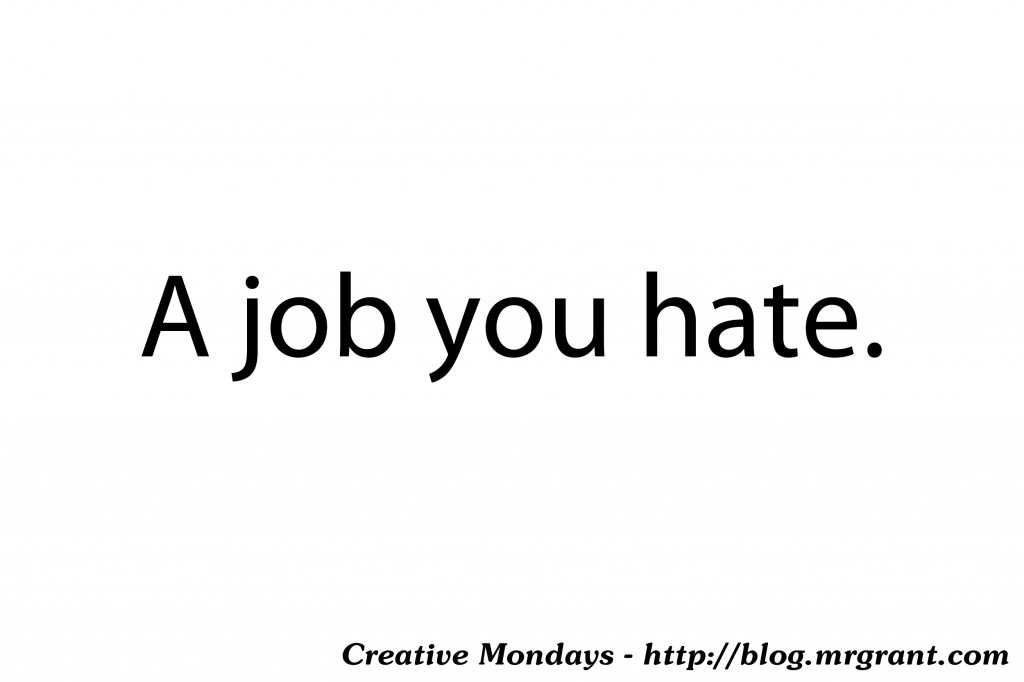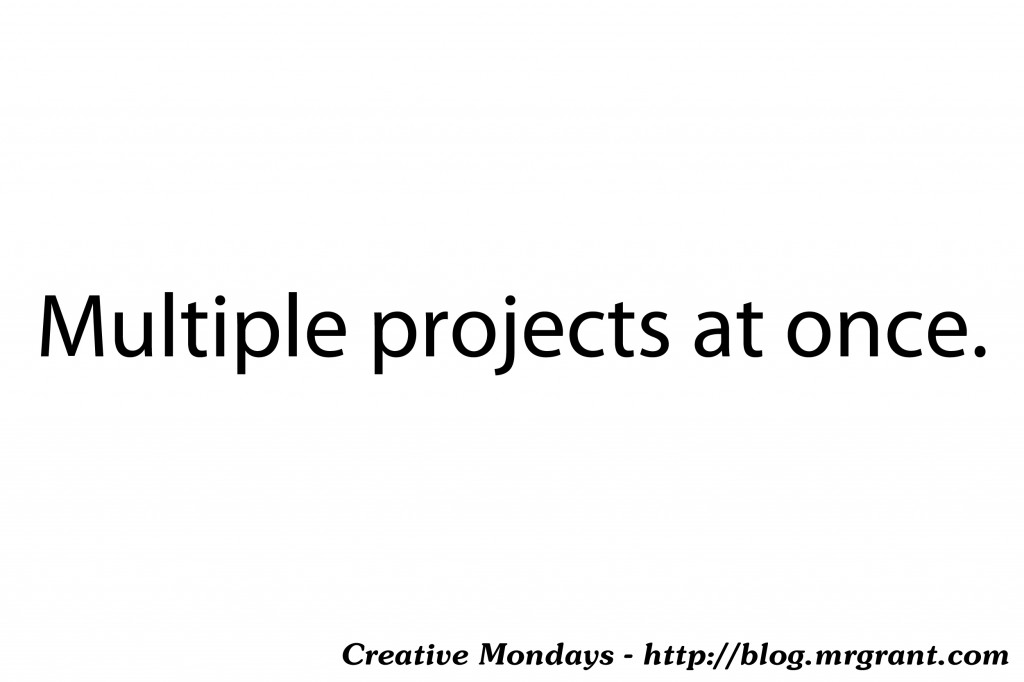Category: Creative Mondays
A year long exploration of creativity.
Creative Mondays #038 – When thrown, just do your best.

Today’s Creative Monday’s post will not be for every artist but it was something I was thinking about today, so I figured I’d write about it. This is more advice for those creative types that go on a lot of auditions or perform live, but it could have an application for painters, sculptors and other artists as well.
Last week, I got an email asking me to come in and audition for a project. I, of course, said yes and the person emailed me info about the audition. It was for a puppet job and over the weekend I familiarized myself with the person that this puppet was based on and felt pretty confident in what I’d do for the audition. Audition day rolls around, and I get there early and I’m totally relaxed and ready to go. The woman who’s running the audition meets me in the lobby and we greet each other and as we are walking to the the elevator she says, “Do you know exactly what we are doing here today?”
I said, “Yes.”
“Great!” she replies, “We’ll get you all set up in the recording booth to see the clips and then you can just do some ADR.
WHAT?! I didn’t say that out loud That’s what my brain said. What I really said was, “Okay.”
I must have said it a little weird because she said, “Did you not know you were doing that?”
I said, “No. I thought this was a puppet audition.”
“It is.” She said, but right now we are just auditioning to do some ADR over some pre-existing clips.”
I smiled, “Okay! Let’s do it!”
Now, here’s the issue. I’ve never done ADR before. It stands for Automated Dialogue Replacement. Another name for it is looping. It’s where you watch a clip from a movie or TV show and then you replace some of the dialogue. This can be an actor replacing dialogue they recorded in the scene that was too noisy to hear, or it can be replacing an actors voice with a new voice, which is what was going on here. Again, I’d never done it before but I thought to myself, “I’m here, let’s do it!” Once we were set up however, I instantly realized that none of the character prep I’d done beforehand was going to work.
This entire audition was turning out to be a complete 180 degree turn from what I thought it was going to be. At the moment I realized this I had two real choices. I could throw a big fit about it and whine and complain saying how I was mislead about what this audition was or I could just give it a shot a do my best. I chose the second option.
You know what? It turned out pretty good. Was I perfect? No, mainly because I’d never done ADR before, but I did good enough to not feel embarrassed. In situations like this I think that really is the only real, professional, choice you have.
When you get thrown, just do your best.
In my years doing comedy music there were countless times on stage where I got thrown. The first time a string broke on stage I was a mess. There have been sound issues, unruly audience members and, heck, crowds that just weren’t into me. In each and every one of those situations, there’s only one real choice. Do your best.
—
What do you do when something throws you while pursuing your art? Do you have other strategies? I’d love to hear them in the comments below. Have a great, and creative, week!
Creative Mondays #037 – If it’s not perfect, it’s not done.

Back in the early weeks of this blog I wrote about going to see Joel Hodgson’s show Riffing Myself gave me a lot of ideas for posts in this blog. Looking back over my notes I found one more that I think deserves mention here.
Joel spoke on how one of the things that really captivated him growing up were the album covers of Roger Dean. Roger Dean is an artist who designed album covers for a lot of different bands when Joel was growing up, and still does to this day. He is probably most widely known for his ‘far out’ designs for the band Yes. He also came up with the, sort of interweaving, logo the band has used for decades. When Joel was younger, Roger Dean collected a lot of his designs in a book called Views and it became a big inspiration to him. He mentioned that not only were Dean’s designs in the book, there were also pictures of the design in process. Starting with rough pencil sketches to the finished project. Joel said this really clued him in to the idea that really great art isn’t just made instantly. There’s a lot of trial and error to getting something right.
Looking at Dean’s work gave him the idea of, “If it’s not perfect, it’s not done.” Dean would labor over something until it is exactly the way he wanted it and this process is all laid out in Views. Joel adopted that in his work in creating. He realized in order for something to be done, it had to be perfect.
I agree with this. I whole heartedly agree that is there is more work to be done on a creative project, it should get done. But there’s also a very dangerous side to this philosophy. It’s one we will delve into again in the coming weeks but, if you’re constantly striving for perfection, you’ll never release your art. You’ll get mired down in getting the current piece so perfect, you’ll never release it.
I don’t think what Joel is talking about when he says if it’s not perfect, it’s not done is that you constantly work on something until it can’t be perfected anymore. I believe he’s saying until your piece of art is the way YOU want it and YOU are happy with it, it isn’t done. Now, I don’t know Roger Dean personally but I think if you asked him, and he was like most artists, he would tell you that there are little pieces of the Yes logo that he wishes were different. And maybe he even changed those things in later revisions. But he worked on the design until he felt it was perfect to show the band and then release.
If you are working on a piece of art and there’s something bugging you about it, change it. You need to be happy with what you release. Don’t release art that doesn’t please you. But don’t spend the rest of your life chasing that perfection. There’s got to be a point when the project is done and you move on to the next one.
I’ve heard it said that writers write books for just one person. I think that can be applied to all fields of art, not just writing. A painter paints to impress one person. A dancer creates a dance to please one person. And I think that person, should be, you, THE ARTIST. If you aren’t happy with what you’re making, do not release it.
If it isn’t perfect (meaning makes you happy), it’s not done.
—
Do you wait until you are happy with a piece of art before you release it? Or do you fall into the trap of always wanting to tweak it and never let it go? Let me know in the comments below. Have a great week!
Creative Mondays #036 – A job you hate.
 After four years of college I was ready to get out of California State University Long Beach and get out into the world, so much so I didn’t want to go to my college graduation. Now my parents, who had had worked very hard to pay for four years of higher education for their son who was getting a theatre degree in acting and direction, had a very different opinion. They were coming down to Long Beach and they were going to see me walk across the stage, get handed a diploma and shake the Dean’s hand. I was really bummed because I really did not want to go but I did want to make mom and dad happy.
After four years of college I was ready to get out of California State University Long Beach and get out into the world, so much so I didn’t want to go to my college graduation. Now my parents, who had had worked very hard to pay for four years of higher education for their son who was getting a theatre degree in acting and direction, had a very different opinion. They were coming down to Long Beach and they were going to see me walk across the stage, get handed a diploma and shake the Dean’s hand. I was really bummed because I really did not want to go but I did want to make mom and dad happy.
Then, a day or so before graduation, I picked up a copy of the Long Beach Press Telegram and in it was an article on the pending graduations and it listed who the guest speaker was going to be at each departments graduation. There, in black and white, it listed the guest speaker for the College of the Arts as Harry Shearer. If you feel you don’t know Harry Shearer, you do. He is the voice of several characters on The Simpsons, he’s the host of the popular syndicated radio show Le Show, he was on two different seasons of Saturday Night Live and, most importantly to me, he portrays bassist Derek Smalls in the band Spinal Tap. Once I read that, no one was going to stop me from going to that graduation.
I’m so glad I did go because that afternoon Harry gave a commencement speech that has stuck with me all these 18 years later. Especially the loin he made about working in a job you hate. I’m going to paraphrase this next part, but his basic point was:
“A lot of people take a ‘real job’ until their dream job in the Arts comes in, in order to survive. Several years later, they are still at that ‘real job’ and are no closer to working in their dream job in the arts.”
Now, Harry said it a lot more eloquently than I just did but the main point is that many in the creative field work jobs they don’t want to be in just to survive and then, years later, realize they aren’t close at all to the job they got their degree for.
I am certainly guilty of this. For years after college, about ten in fact, I worked as a substitute teacher. It was an okay job, certainly flexible enough and I was making money, but by the end of those ten years I was starting to burn out because it was not the job I wanted to be doing. I was good at it and several times I was told I should get my teaching credential because I was such a good teacher. But deep inside of me I could feel a darkness building up because I was doing a job I absolutely hated.
The moment I made the decision to stop subbing and focus on The Radio Adventures of Dr. Floyd, it felt like a weight was instantly lifted from my chest. I attempted, for the millionth time, to lose weight and it was actually working (lost 80 pounds). I was just a million times happier than I was when I was subbing. And guess what? I became more creative! This was the creative boom era for Dr. Floyd, because I was doing something I love.
Now, Dr. Floyd didn’t become a full time job, far from it. But working on that show lead to another job, producing a podcast for The Jim Henson Company, which did become a full time job. A job I was much happier to be at, and paid much more than, substitute teaching.
From that point on, I’ve had to remind myself of this whenever I get down about money. And even in the creative world I’ve taken jobs just because ‘I needed the money.’ To me, in the long run, it’s just not worth it. I become unhappy, miserable to be around and not really a good worker in those jobs I hate. At the end of 2013 and the start of 2014 I had gotten myself into two jobs ‘because I needed the money.’ Though I was quickly reminded why I should never do this, I finished out those jobs because I had agreed to do them. A good refresher to really think about a job before before agreeing to it. Is this what I really want to be spending my time on? Is this going to make me happy?
Ed robertson of Barenaked Ladies said in an interview once, “You can’t do what you want, doing what you don’t want.” I’m a big believer in this. You need to be happy in what you’re working on. For your health and sanity.
Incidentally a few years ago, I emailed Harry Shearer via his website asking if he had a copy of the speech still that he could send me. He said that due to an encounter his laptop had with a spilled bottle of wine on an airline flight he did not. My Great Aunt videotaped the graduation and got part of his speech on video. I should track that down.
Finally, I wanted to add one other piece to this. A piece I know a lot of people will think when they read this. You need money to survive and sometimes, a lot of times, the creative stuff does not even come close to paying the bills. I get that. So I wanted to add a short story with a piece of advice a friend of mine once gave me.
Tiffany Carboni was a year ahead of me at Burlingame High School. She graduated and was in Los Angeles for a year and when she came back the next summer we were talking about he job working with Michael J. Fox’s production company. I told her about wanting to go to LA and get into the Hollywood biz and she said (paraphrasing here), “Never be afraid to take a job that you will have no problem quitting a few weeks, or months later. Know that you aren’t there permanently. It’s just temporary until the thing you want comes along.”
This is why, for a year after college, I worked in a record store. It was an okay job and I was good at it but I had no qualms about quitting (with a two week notice, of course) when something better came along. In fact, I did quit to work on a play and then a few months after that, I got my old job right back and worked there for a little longer.
—
Have you (or are you currently) working a job that you hate? Is it keeping you from pursuing your creative dreams? You may not be able to quit tomorrow and become a full time artist, but how can you start the process to start doing what you WANT to be doing?
Creative Mondays #035 – Multiple projects at once.

Today I want to talk about a creative thought that hits close to home. Having too many projects going at once. This is something I have a particularly rough time with. I usually have way too many creative projects going at one. At any given time I have ideas for audio podcast scripts, video podcast scripts, Throwing Toasters songs, completely new show ideas I want to develop and more.
I got the book Jim Henson’s Doodle Dreams and was looking through it and came across this quote by Jim Henson:
“Try to keep enough balls in the air so that when some fall to the ground, you’ve got others up there.”
I immediately loved that quote because I felt it really capsulated my feelings about how I work on creative projects. I read that as:
Be working on a bunch of projects so that if some of them don’t work out, you’ll still have others to work on.
The inherent danger in this, though, is that you have so many creative projects you are working on that none of them get done. This is certainly something I run into, however I like to think I prioritize creative projects pretty well. I will focus on one particular project and work on that one for awhile, but in the meantime I’ll be making small amounts of progress on other ideas. I find that working on multiple projects also keeps me from suffering burnout working too much on one project. Moving from project to project keeps the creativity flowing in my mind. Of course any creative project that someone is paying me to create takes precedence over personal ones that do not pay because, you know, money.
When working on multiple projects, also be careful about ‘bleed through’ unless it is intended. Bleed through is when elements from one project creep into another. I find this is more of an issue for me when I’m writing. I’ll look back through the stuff I’ve written and see that I’ve used the same names or same strings of dialogue. This is fine if I was writing multiple stories involving the same characters but often I am not. Bleed through won’t kill a project, it’s just something to keep an eye out for. In my case, I don’t want people saying, “He’s just writing the same story over and over again.” (As a side note to this, I do often write the same of similar jokes across multiple projects if they fit. I figure if one property hasn’t ‘made it’ and there’s a really good joke in it, there’s no reason not to use to make another property even better. That’s not bleed through as I’m doing it on purpose.)
When working on my own creative projects I often wear many hats: writer, producer, performer, editor, publisher. I can do all those jobs and often do. Though I’m not a rabid fan of Seth McFarlane, I do admire his work etheric on Family Guy. He created the show, writes it, performed in it and more. Back when there was a possibility of a Dr. Floyd television show, I was eager to do all those things should the show go forward. In my own projects now, I’m excited to do all those things.
Sometimes, I find, we MUST be all those things in our own creative work. At least until we are as famous as Seth McFarlane and we can have other people cover some of other aspect.
—
Are you an artist handling multiple creative projects at once? If so, how do you keep them all straight and get them all done? Let us know in the comments below. Have a great week!